Located at the southern tip of Kyushu, Kagoshima is known for its fabulous food and the neighboring active volcano Sakurajima. Explore the city with us as we learn its rich history and visit the beautiful Japanese garden Senganen.

Kagoshima is famous for fabulous food and drinks (shochu), the active volcano Sakurajima, Sengan-en garden, and its rich local history tied to the Satsuma Rebellion. We spent 1 day in Kagoshima after visiting Yakushima and toured the many sites in the city. Ready to join us? Let’s go!
Where is Kagoshima
Kagoshima is located on the southern end of Kyushu and the fastest Shinkansen from Tokyo will take almost 7 hours. If you’re traveling from Tokyo, flying is the best option since it takes only 1 hour 40 min flight and the cost is similar to Shinkansen. From Osaka, it’s about 4 hours to Kagoshima on the Shinkansen.
We arrived in Kagoshima on the hydrofoil from Yakushima (2 hr ride). It was our first time riding on the hydrofoil and quite an interesting experience. Even with choppy waves, the ride was super smooth with the boat going quite fast (50 mph/80 kph).
Why Go to Kagoshima
Kagoshima is not a large city but there is plenty to see and do. For a more easygoing trip, plan on a 3-day visit that will allow you to experience majority sites of the city, which includes hiking on Sakurajima. Our 1-day trip was way too short.
When you are in Kagoshima, you will see and hear the term “Satsuma” (薩摩) quite often. The Kagoshima area prior to Meiji Restoration (around 1868 when the imperial rule was restored in Japan) was long ruled by the Shimazu family for almost 800 years. The area Shimazu ruled was called Satsuma Domain. Therefore, Satsuma is used frequently especially for local food and craft such as Satsuma beef, Satsuma chicken, Satsuma-age, and Satsuma Kiriko.
Kagoshima Food
One of the highlights of Kagoshima is its fresh food and regional cuisine, especially its beef, kurobuta (Berkshire pig), and Satsuma chicken. Besides meat, Kagoshima is also famous for eel and many kinds of seafood.

Our ferry arrived around lunchtime so our first stop in Kagoshima is a popular restaurant called Kumasotei (熊襲亭). Kumasotei specializes in signature regional dishes which include kibinago sashimi, chicken tataki, kurobuta shabu shabu, Satsuma-age (deep-fried fish cake), and tonkotsu stewed pork.




All the foods were excellent and we were not disappointed. The lunch course set that covers the main dish, sashimi, Satsuma-age, and various side dishes ranged from $20-30 USD.
Sengan-en 仙巌園
After lunch, it’s time to burn off some calories and walk around the expansive Japanese garden Sengan-en. Sengan-en was built by the Shimazu family (also written as Shimadzu) in 1658 and offers spectacular views of Sakurajima and Kagoshima Bay. The traditional garden also includes a villa lived by the Shimazu family.
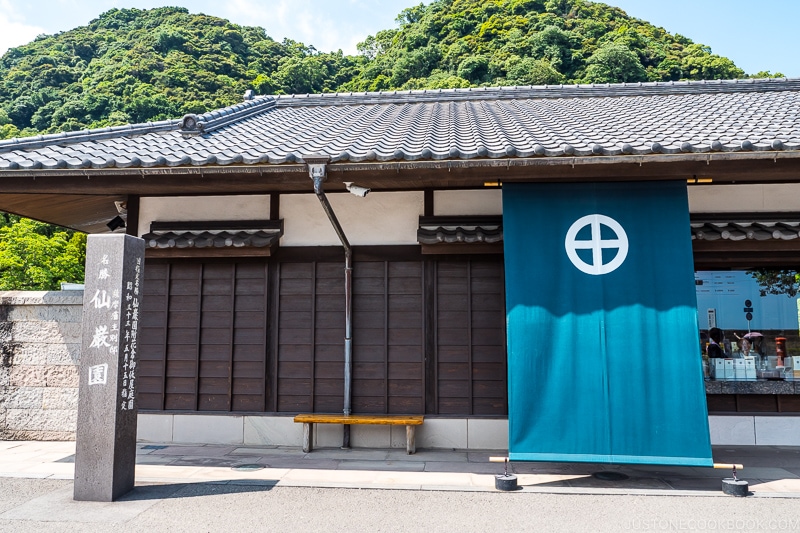

Being early adopters of western knowledge, the Shimazu family played an important role in bringing industrial technology to Kagoshima. One such technology was the reverberatory furnace built by Shimazu Nariakira to melt iron.
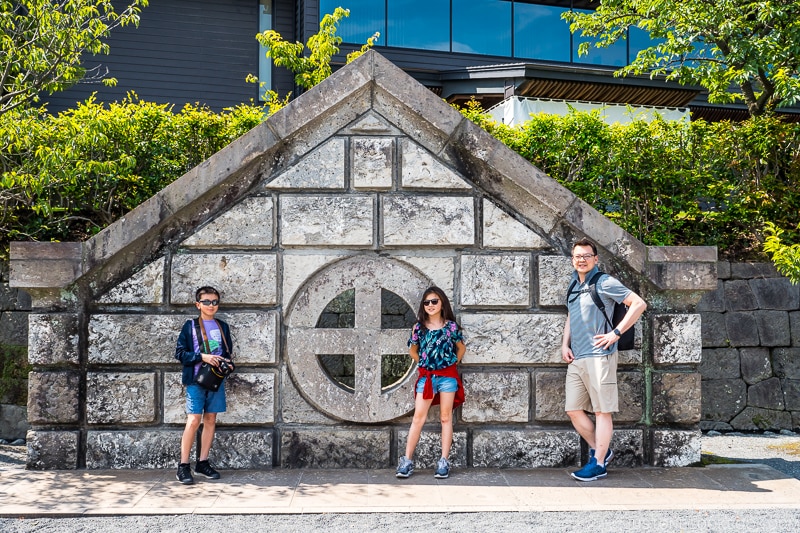




In the north end of the garden is the villa used by the Shimazu family. It was used as a state guest house to receive foreign guests in the 19th and 20th centuries. The house is fairly large and visitors can walk through the halls and see the exhibitions inside.
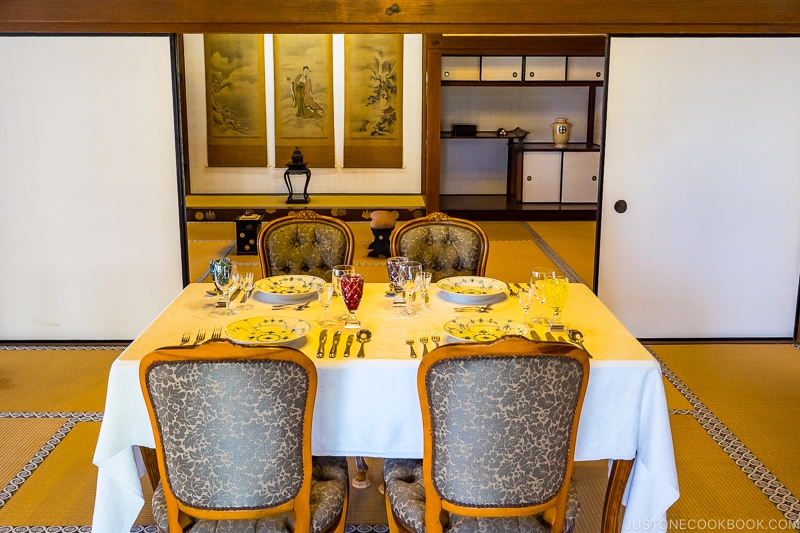


From Sengan-en, we took a taxi back to central Kagoshima. The driver was very kind and offered to take us to the popular sites within the city so we were able to see quite a bit in a short time.
Terukuni Shrine 照国神社
Our next stop is the Terukuni Shrine. One of the most influential leaders in Kagoshima’s history was Nariakira Shimazu 島津 斉彬 (1809-1858). He was responsible for leading the industrialization and modernization efforts in the area, including ironwork, glassmaking, westernized military training, and shipbuilding.

Nariakiria Shimazu was so revered he was enshrined at Terukuni Shrine. A rare honor bestowed by the emperor.


Saigo Takamori Statue
Just a few blocks away from Terukuni Shrine is the large 8-meter statue of Saigo Takamori. Saigo Takamori is a legendary figure in the Kagoshima area and sometimes referred to as the last true samurai.
There are many stories about Saigo Takamori’s life and many movies (The Last Samurai) and dramas made about him. The short version is that he was a close adviser to Shimazu Nariakira, and a war hero for the imperial government helping take down the ruling Tokugawa shogunate. With his military accolades, he played important roles for the Meiji government including the responsibility to organize the national army and leading the imperial guards as a general.

Later on in life, Saigo Takamori disagreed with the imperial government’s policies and left to go back to Kagoshima to retire. In early 1877, he came out of retirement and became the leader of the Satsuma Rebellion against the Meiji government. The battles raged on until Sept and he lost his life at the Battle of Shiroyama.
Besides the statue, other significant Saigo Takamori landmarks include Saigo’s cave, his death place, and his cemetery.
Saigo’s Cave 西郷隆盛 南洲翁 洞窟
Not far from the statue, up the hill on Shiroyama are the caves where Saigo spent the last days of his life retreating from the imperial military.

Saigo’s Death Place 西郷隆盛終焉の地
After being hit by bullets during the battle of Shiroyama, Saigo asked his follower to cut off his head subsequent to his warrior’s suicide. Visitors can stop by the landmark today to pay respect.

Saigo Nanshu Museum and Cemetary 西郷南洲顕彰館
Lastly, there’s a museum dedicated to Saigo’s life and personal belongings near his cemetery. The cemetery contains Saigo’s remains along with his comrades who lost their lives in the Satsuma Rebellion.


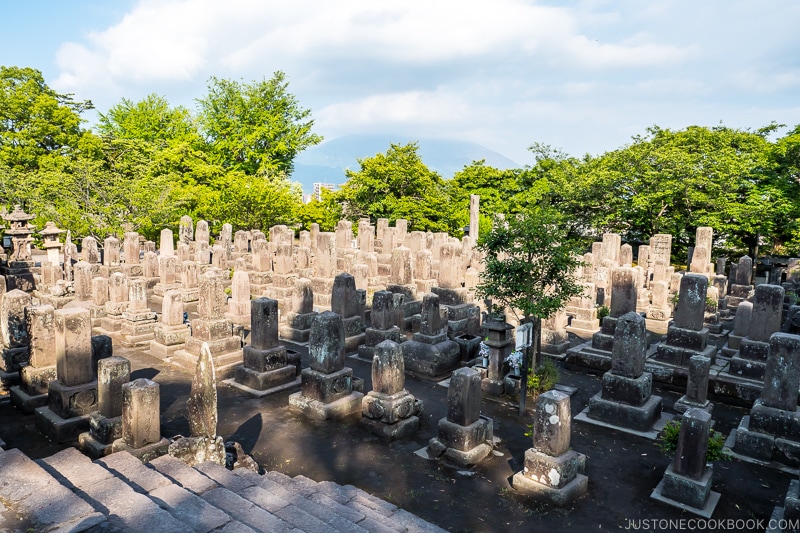
Shiroyama Park Observation Deck 城山公園展望台
To take in the view of the city, head up to Shiroyama Park Observation Deck. The observatory has a walking trail for visitors to take in the views of Kagoshima and the surrounding area from 350 feet (107 meters) up.



Shopping in Kagoshima
If you are looking to buy souvenirs or gifts on your trip, head over to the Tenmonkan shopping district (天文館). You can find all types of retail shops and restaurants here. Make a quick stop at Yamagataya (山形屋), the famed department store founded in 1751.
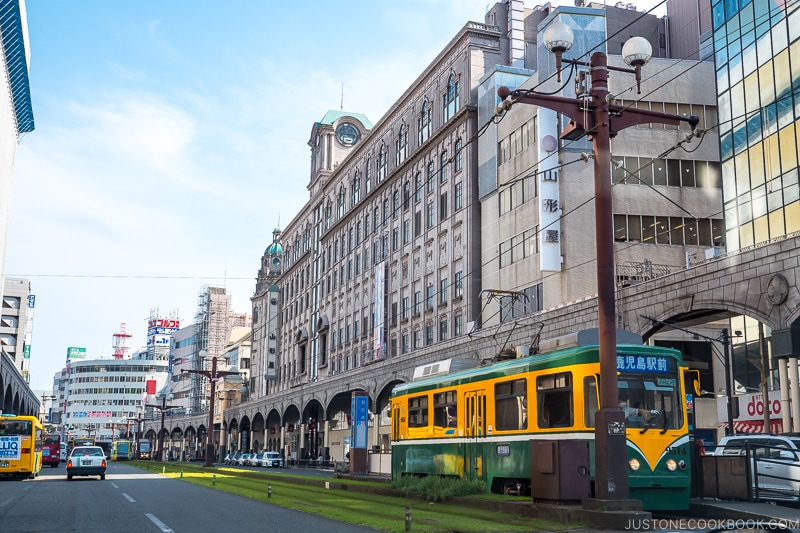
Kagoshima Chuo Station 鹿児島中央駅
Another area for shopping is right around Kagoshima Chuo station, with many restaurants, shops, and plaza nearby.

Check the Kagoshima Convention and Visitors Bureau website for more ideas.
Sakurajima 桜島
We didn’t have a chance to visit Sakurajima during our trip but many visitors stop by this active volcano for a day trip. Visitors can hike and sightsee from various observation points on Sakurajima. The ferry runs frequently between Kagoshima and Sakurajima.

Shiroyama Hotel 城山ホテル鹿児島
We stayed at Shiroyama Hotel during our visit to the city. The hotel is located on top of Shiroyama and many of the rooms have a great view of the city.


Our stay included a kaiseki dinner which was decent, but not superb. We had higher expectations for one of the nicest hotels in Kagoshima.



However, breakfast at Shiroyama Hotel was one of the best we’ve ever had. There are over 50 items available for the breakfast buffet and the quality was amazing for the incredible selections they offered!



We hope you enjoyed the quick tour of Kagoshima. There are so many parts to the city we didn’t get to experience so we hope to go back one day. The next part of our trip we’ll be heading north to see the colorful ceramics in Arita and Imari.

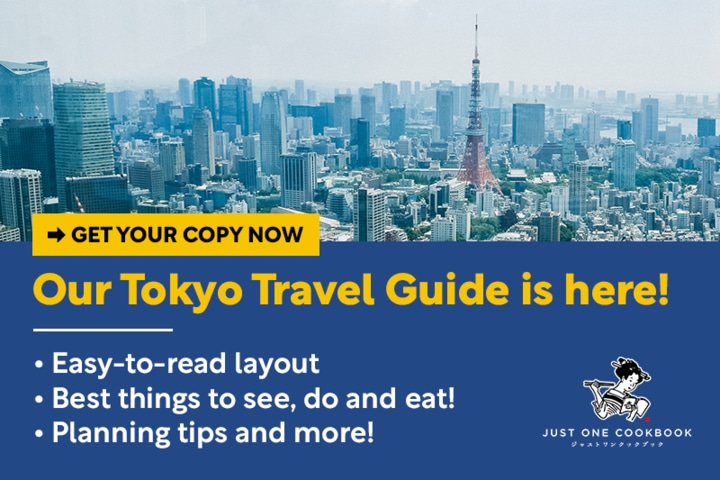










[…] left Kagoshima by taking the Shinkansen north to Shin-Tosu Station and transferred there to Midori-Huis Ten Bosch […]
So beautiful. I would love to go someday.
Thank you for a beautiful trip thru the country side..your family looked so happy. The foods looked delicious
This was the last trip I made before C19 struck. Had to get used to. Wearing a mask because of the erupting volcano. Kyushu is wonderful
Hi Jules,
So glad you got to see the beautiful Kagoshima! We agree with you that Kyushu is wonderful and more people need to visit (when possible)!
I was fortunate to visit Kagoshima in the 1990s as part of an exchange program between Colorado Springs and Kagoshima. I had a homestay with a family there, and had wonderful food, relaxed in an onsen and enjoyed a matsuri with street dancing that looked just like American country line dancing. I love the history there, and the looming presence of Sakurajima, which erupted the first night we were there, spitting dust on the entire city. It’s a beautiful place!
Hi Gil,
Thank you for stopping by and letting us know about your time there. Did you get a chance to visit again after the exchange program?
Oh yes, though there was a fairly long break after 1995. The next year a delegation from Kagoshima came to Colorado Springs. After that I think I traveled to Japan three times with my mother, who is from Nemuro, on the easternmost tip of Hokkaido. Since about 2010, I’ve been a few more times, with my wife and my mom, and with my wife’s parents and last year, with my wife, her parents, her brother and his partner. In recent years I’ve been the “travel agent” and trip planner, booking flights and trains, and hotels. Last year we went to Tokyo, Kyoto, Osaka … very typical tourist visit. I was born in Tokyo and my family moved to the US when I was 8, so I have very vivid memories of Japan, albeit Japan of the early 1960s! Please tell Nami that my article about her should run in the Pacific Citizen newspaper should finally run this week. Then I’ll post it on my blog too.
Thank you for this travel guide- very helpful. I have just started collecting ideas for planning our 3rd trip to Japan. Our son loves military history so this puts Kagoshima on our list of possibilities.
Welcome back, Nami and I hope recovery continues to go well.
Hi Nikki,
Not sure if you’ve visited Kyushu on your previous trips but it’s one of our favorite areas to visit. It’s not as touristy as other parts of Japan and the food is absolutely underrated!
Hi Nami. Glad you are back. Hope the arm is heeling well. Thanks for the tour of Kagoshima. We stopped there last year on a cruise and I loved it. Such an interesting place. (Also nice to see your gorgeous kids!)
Hi Jane,
Thank you for your kind comments and stopping by to read the Kagoshima post!
I was lucky enough to live in Kagoshima when I was an English teacher. Kagoshima is overlooked and underrated due to its location. I encourage people to take the extra time to go visit because they will fall in love and want to come back! It’s a gem of a city where the food and scenery cannot be beat. Come back in each season for the full spectrum of delights! Including the Kagoshima-ben and the AMAZING variety of hot springs. I miss it so much.
Hi Kelli,
We absolutely agree! Perhaps it’s not easy to get to from Tokyo so people are not as aware of it. We want to go back just for the food!
My family is from Kagoshima. I am sansei but I still have dear family in Kagoshima. It makes me so happy to see familiar places. I love your website! Being sansei makes it challenging to keep up with traditional foods. Food is so important to cultural identity. It is wonderful to share your recipes with my daughters. Thank you!
Hi Sabrina,
Thank you for stopping by! We really enjoyed our trip in Kagoshima and wished we had more time there. Did you get to visit your relatives in Kagoshima often?
Your post made me nostalgic for my wonderful visit there when I lived in Fukuoka. After being in quarantine for 3 months in NYC, I’d give anything to be able to go back.
The NHK channel in the Bay Area has a wonderful “Somewhere Street” episode that features this region. I love all of their programs but this one was so interesting! The food, the people, the scenery and history!
Hi Lucy,
We mostly watch NHK food shows but will check for the “Somewhere Street” program. Thank you for letting us know about it. Kagoshima’s unique culture is very interesting and we learned quite a bit when we were there.
Hi Melissa,
Thank you for stopping by. We miss Japan dearly as well (had to cancel our summer trip) and it’ll make that next trip even better.